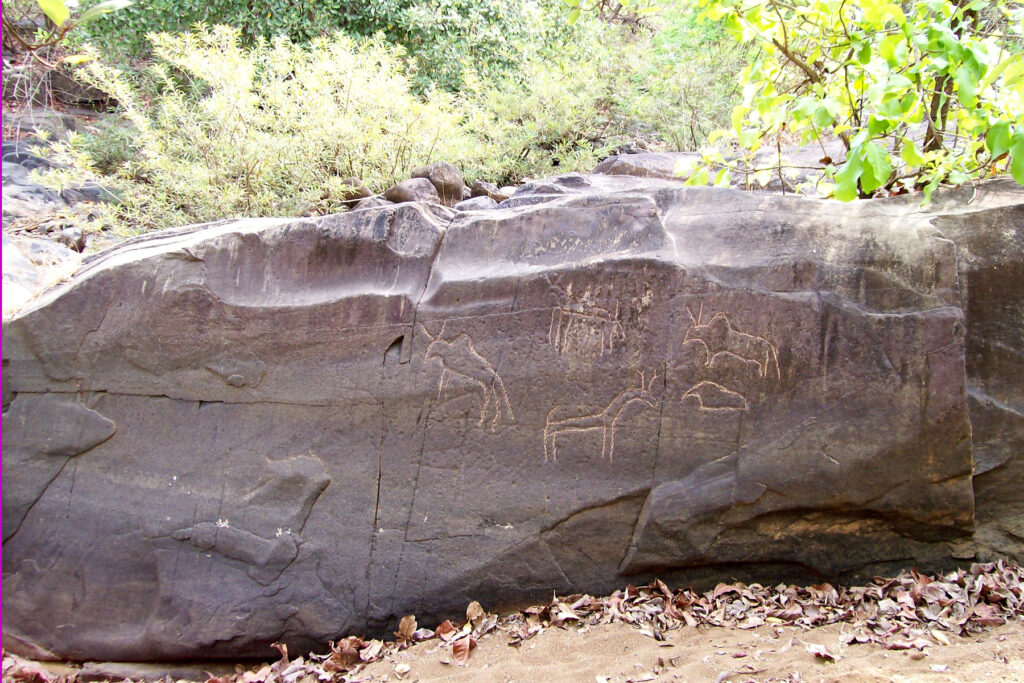‘Writings’ or written material is the main source for researchers of history. But the history of writing itself is very recent. Prehistoric man did not have writing skills. But he left us some of his footprints in various forms, such as paintings or graffiti on the walls of caves, carvings on the stones, etc. This form of ‘writing’ is known as ‘rock art’, found in almost all parts of the world. To find these sites is a tedious job, but the most difficult part is to decipher them.
The ‘Three Age’ system
In human history, technology of tools devised and used by man defined the age in which man was living. Hence, Stone Age was followed by the Bronze Age, and later, the Iron Age. Rock Art, also known as ‘rock carvings’, ‘rock engravings’, ‘rock inscriptions’, ‘rock drawings’ and ‘rock paintings’, flourished mostly in the Stone Age when man was a hunter gatherer, or was living in caves. Stone Age is again broadly divided into three parts, namely, the Old Stone Age, the Middle Stone Age, and the New Stone Age, each indicating progressive technological and economic advancement of human existence.
The Stone Age begins with the first production of stone implements, and ends with the first use of bronze.
Types of rock art
Rock art is prehistoric man’s markings placed on stone. This global phenomenon, found in culturally diverse regions of the world, has been produced in many contexts throughout human history. The majority of rock art has been produced as part of a ritual.
Rock art in Maharashtra
In the last few years, a large number of petroglyph sites have been found in the Sindhudurg and Ratnagiri districts. A huge granite boulder with beautiful rock carvings, including big, humped bulls, boar and other animals was found at Virdi village in Sindhudurg district, near Maharashtra-Goa border. Unfortunately, due to apathy and ignorance, this heritage site was vandalised and destroyed while constructing a dam some 10 years ago.
Petrolyphs in Sindhudurg
More than 125 forms were found scattered at Usgalimal, also called Panasaimol, near Sanguem, by the Kushavati river. This site was a prehistoric riverside nomadic fishing camp, discovered in 1993.
The Virdi boulder
At Virdi, there was a huge basalt boulder on which some animals including a pig, a giraffe like animal locally called Zebu, and a couple of humped bulls were carved. Unfortunately, this huge stone was destroyed five years ago while constructing a dam. The third site is at Hiwale near Kasal in Sindhudurg. Here we can see human figures, birds, fish and circles.
Kudopi’s ‘Hill of the Dolls’
Over 30 petroglyphs were spotted by me on a huge lateritic plateau on top of a hill, locally known as “Bawlyanche temb” in Marathi, which means ‘A hill of dolls’. This site is located near Kudopi, a small village in Malvan tehsil of Sindhudurg district. A river flows below the hill. The drawings consist of two human figurines, circles, a pair of fish with the water body artistically carved, and a mother and child showing the prevalence of fertility cult, a common occurrence worldwide. Other drawings, though artistic, are difficult to decipher as they are abstract in nature.
Rock art sites in Ratnagiri
In another coastal district of Ratnagiri, researchers have found around 850 rock carvings at 71 places in 43 villages. This is a huge conglomerate found in Maharashtra till now. These sites are scattered in Lanja, Rajapur, and Ratnagiri talukas. The villages include Bhade, Harche, Hanawali, Lawgan, Dewache Gothane, Goval, Upale, Panale, Shede, Devihasol, Malapwadi, Jaigad, Chave, Karbude, Niwali, Golap, Kapadgaon, Kolambe, Ganeshgule, and many others. Animals, humans and geometrical figures are carved on laterite surface at these sites.
Rock shelters in Chandrapur
Rock art sites in Vidarbha have been known to archaeologists for the past 15 years. Painted rock shelters have been recorded at Parasgarh-Nagbhir Hills, and Waghai Hill in the Chimur taluka of Chandrapur district near villages of Navtala, Dongargaon Budruk, Pandubara and Nagargota. A group of four rock shelters were found at Pandubara, two of which bear paintings of animals in red. The animal figure is filled in red, depicting prominent ears in front, and a raised tail. Two beautiful deer figures are depicted aesthetically, and a few of the paintings are superimposed. A large panel might have been used as a canvas for creating these figures as some traces of paintings can still be seen.
The other shelter has paintings of six figures in red outline on its ceiling. Another shelter, located below this one has been converted into a shrine by the villagers, and people from the nearby villages flock to this shelter for worship during festivals. This shelter is known as the Pandava shrine, and the group of four shelters at this site has been named accordingly.
The fourth shelter at this site is known as the Barasingha shelter, as two beautiful figures of barasingha, with prominent antlers facing each other, have been painted in red at this shelter.
Sitechi Nhani or Sita’s bath enclosure
A huge rock shelter is located on the hill known as ‘Sitechi Nhani’ ( Sita’s bath enclosure). This place is covered by huge sandstone blocks and deep grooves can be easily seen above it. The rock paintings here are found on the exterior and cliff sides of the rock shelter. A row of paintings has been found on the panel. On this panel a prominent boar figure, along with a few human figures are depicted.
Local villagers have cut a chamber into the rock here, and have placed an idol of Sita in it, which they worship. Three shelters have been found below the bath enclosure, which are highly vandalised with modern graffiti.
The Kalachakra (Hirva Jhari)
The site is located towards the west of Jhari village at the foothills of Waghai Hills in Chimur taluka of Chandrapur district. The site is so named as a circle, one metre in diameter, with cupules in a linear pattern and encircled by small stone blocks, has been found. This site seems to be a potential Stone Age site as microliths have been found here.
Rock art studies require an integrated effort that brings together archaeological theory, fieldwork, analytical techniques and interpretation. If interpreted correctly, these footprints of our ancestors may tell interesting stories of that time we cannot even imagine now.


 [/column]
[/column]